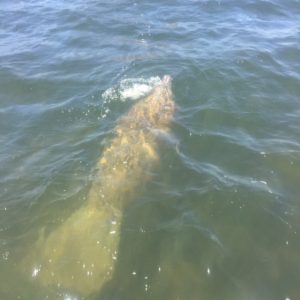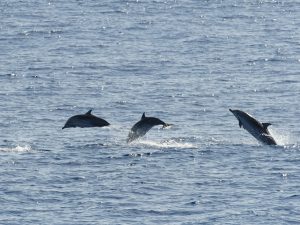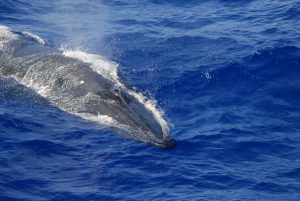When it comes to charismatic wildlife, there are few that are more than marine mammals. Everyone loves whales and dolphins. Even today, as many years as I have been working on the water, my colleagues and myself still get excited when we see dolphins. Seeing a whale is like a life-long bucket item. Marine mammals are pretty exciting to see.
In the world of marine mammals there are four different groups. Of course, there are the whales and dolphins (the cetaceans), there are the seals and sea lions (pinnipeds), the manatees (sirenians), and… believe it or not… the polar bear (ursids). But we only find two of these in the Gulf of Mexico. The polar bear, of course, does not live here. I know you needed to hear that from me. Pinnipeds no longer live here. Many may be surprised that there was once the Caribbean Monk Seal. There are records of this animal in the southern Gulf, but it is now extinct. There are records of California Sea Lions in the Gulf, possible release from some aquarium program – who knows, but no one has seen any in decades and it is believed they no longer exist here. So that leaves the cetaceans and the manatee.
The most recent publication (2017) states there are 28 species of cetaceans in the Gulf of Mexico. Cetaceans are subdivided into two groups: the baleen and the toothed whales. It is believed that 27 of the 28 species in the Gulf are toothed whales. Baleen whales are the big boys, 50-100’ in length and weighing tons. Some are the largest animals that ever existed on our planet. Most prefer cooler waters. Records of species come from whaling logs of the 19th and early 20th century as well as more recent scientific surveys and records from the Texas Marine Mammal Stranding Network. Early records suggest that right whales, humpbacks, sei, and even blue whales have been seen – though most of these were from the southern Gulf. But more recent science surveys indicated that only the Bryde’s Whale is encountered, and those are not common.
The majority are toothed whales. These would include the largest of them the sperm whale. Made famous in the novel Moby Dick, sperm whales were sought by whalers for their blubber and spermaceti. The blubber was boiled down to oil and used to light street lanterns and light houses. The spermaceti was used for a variety products including cosmetics. The sperm whales in the Gulf appear to be smaller than their counterparts in the open ocean and may be a separate subspecies. They seem to linger off the coast of Texas and Louisiana feeding on squid found at great depths.
Another toothed whale reported is the Orca, or killer whale. These are rare and are most often spotted in the central portion of the Gulf. There are numerous beaked whales and dolphins, but – though reported in early whaling logs – recent surveys suggest there are no porpoise. Porpoise differ from dolphin both in size and tooth shape. The most abundant dolphin is the pantropical spotted dolphin. Those who lived in the area in the 1980s and early 1990s might remember a stranding of dolphins that involved an adult female “Mango” and small baby named “Kiwi”. Mango died during recovery, but Kiwi lived for many years at the Gulfarium in Ft. Walton – these were pantropical spotted dolphins. The most familiar, and most often seen, are the Atlantic Bottlenose dolphins. These are a coastal species, many pods living within the estuary itself. They are the stars of many aquarium shows.
As you might guess, toothed whales are all carnivores. They only have canine teeth, so they must swallow their food whole. Their favorites are fish and squid. They have an amazing sense of echolocation that can help them navigate waters, detect prey, and even “stun” prey making it easier to eat. They give live birth as we do, and the calves stay with their mom for about two years learning how to survive. Cetaceans are very social forming groups known as pods. Most pods are dominated by females and young. Only one or two males are present.

A lone manatee spotted in Big Lagoon near Pensacola Pass. Sightings like these are becoming more common.
Photo: Marsha Stanton
Manatees are members of a group called Sirenia. This name comes from the fact that Columbus’ crew thought they were mermaids – “sirens of the sea”. It has been said before, that if they thought manatees were mermaids – their idea of a mermaid, and ours, is very different. That said, that is where they get their name. There are four species of sirenians on our planet, the one found here is the West Indian Manatee. They are found through the Caribbean, South Atlantic, and Gulf of Mexico. It is believed now that there are two subspecies – the Antillean of the Caribbean, and the Florida manatee from our neck of the woods. These are slow moving herbivores who can tolerate freshwater. They have a low tolerance for cold water and seek warm water springs, and the warm water discharges from power plants, during the winter.
Manatees are not as social as cetaceans and are usually not found in large groups unless they gather in warm water spots. Females usually give birth to a single calf which stays with her for about two years. They have flat molars, like cows, and feed on a variety of plants – the source of their other common name… “sea cows”. The numbers of these animals have increased in recent decades, but they are still low, and the animal is still protected. Boat strikes is one of the leading causes of death, though red tide, and cold stunning are also problems. Sightings of these animals in our area are increasing and we are currently tracking encounters at the county extension office. If you see one, please contact Rick O’Connor at the Escambia County Extension Office – (850) 475-5230, or roc1@ufl.edu.
Though the days of “Save the Whales” and “Save the Manatee” are not as common, these animals still face low numbers and problematic encounters with humans. Fishing gear, boat strikes, sounds, all take marine mammals in the Gulf each year. Hopefully we all get to check off seeing one of these magnificent creatures from our bucket list before the end of our time.
Resource:
Wursig, B. 2017. Marine Mammals of the Gulf of Mexico. In: Wards, C. (ed.) Habitats and Biota of the Gulf of Mexico: Before Deepwater Horizon Oil Spill. Springer, New NY.
- Rattlesnakes on Our Barrier Islands; Part 4 – Thermoregulation - December 29, 2025
- Rattlesnakes on Our Barrier Islands; Part 3 – Envenomation - December 22, 2025
- St. Joe Red Tide Claiming Terrapins - December 15, 2025



